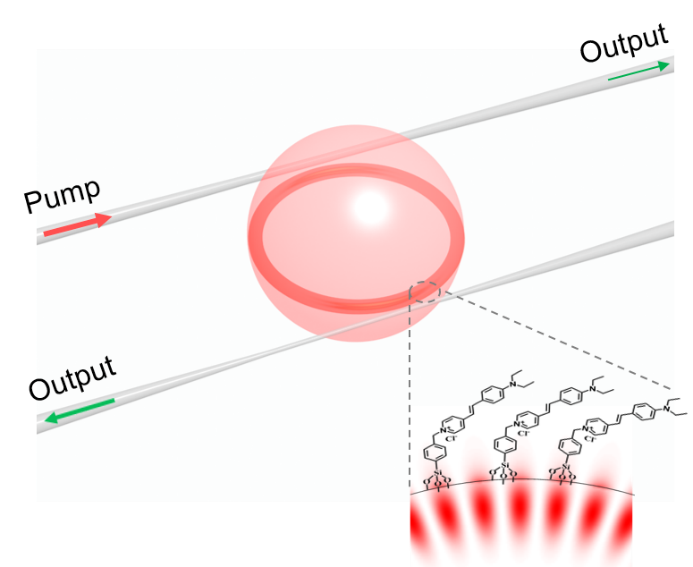Silica optical microcavities are mainstay photonic devices for their intrinsically ultralow loss in the broadband spectra and the mature fabrication in modern technology, but unfortunately suffer from low second- and third-order optical nonlinearity. A notable feature of the microcavity is the inherent leaking evanescent field at the surface, which opens the window for light-matter interactions at the surface.

|
Figure 1: Schematic of the organically functionalized silica microcavity with dual fiber couplers.
|
Now, a research group led by Professor Yun-Feng Xiao at Peking University, in collaboration with Professor Xiaoqin Shen at ShanghaiTech University has achieved record-high efficient third-harmonic generation (THG) in a surface functionalized silica microcavity. This work has been published online in Physical Review Letters with Editors’ Suggestions and cover report, entitled “Microcavity nonlinear optics with an organically functionalized surface”.
In this work, conjugated organic molecules are employed for the functionalization of the microcavity surface, which hold very large nonlinear optical response due to their large delocalized electron systems. Through surface functionalization strategy, it is promising to bridge the high quality factor (Q) microcavities with the vast library of nonlinear molecules.
Given the geometry and material dispersion in a cavity, the optical frequency mismatch for pump light and third harmonic (TH) signal with their corresponding cavities modes can spoil the doubly resonant enhancement of TH output, especially in ultrahigh-Q microcavities. "The surface enhanced third-order nonlinearity is one part of the story for efficient THG," said Jin-hui Chen, a “Boya” postdoctoral in the group of Professor Xiao. "We develop the dynamic-phase-matching method by leveraging the Kerr and thermal effects to tackle the challenging optical mode dispersion in ultrahigh-Q microcavities."
These effects collaboratively introduce a frequency shift of the cavity modes, and lead to the dynamical compensation of both the pump and TH resonance mismatch. As a result, the bright TH signal is observed under a pump power of several milliwatt, with maximized conversion efficiency as high as 1,680%/W2, which is four orders of magnitude higher than that of the best reported pure silica microcavities. Note that the ultrahigh conversion efficiency is contributed by the strong nonlinearity of organic molecules and the ultrahigh-Q-resonant enhancement of both pump light and TH signal.
To further identify the origins of the nonlinear signals, the researchers analyzed the pump polarization dependent TH or third-order sum frequency (TSF) output. They found that the output TH or TSF power with a transverse-electric pump polarization is averagely 2 orders of magnitude higher than that with a transverse-magnetic pump polarization, which is due to the surface alignment of organic molecules.

|
Figure 2: Observation of multicolor light emissions from third-order sum frequency generation in a surface organically functionalized microcavity.
|
"The experiment achieves the highest record of THG efficiency in silica photonics," said Professor Xiao. "Even more important, the work may open up the new horizon to improve properties and expand applications of microcavities, which is made of the conventional bulk materials, such as silica and silicon nitride. The technology and mechanism we learned and developed in this work, including the surface functionalization and dynamical-phase-matching method, will perform as the ground stone for various applications, especially in broadband tunable nonlinear photonics."
More information: Jin-hui Chen, Xiaoqin Shen, Shui-Jing Tang, Qi-Tao Cao, Qihuang Gong, and Yun-Feng Xiao, Microcavity nonlinear optics with an organically functionalized surface, Physical Review Letters 123, 173902 (2019).
